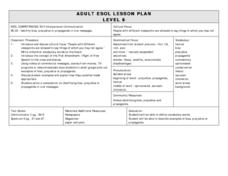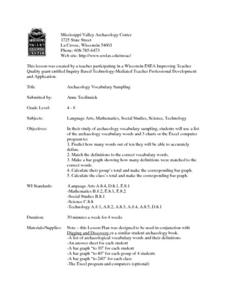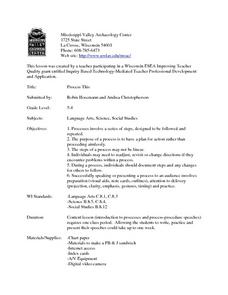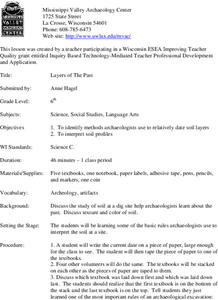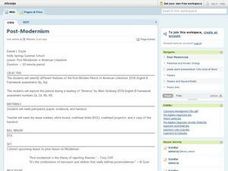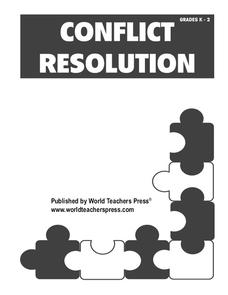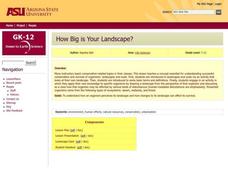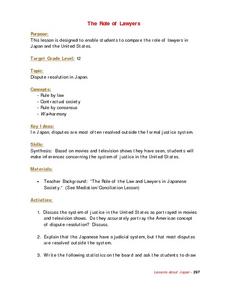Curated OER
Agree To Disagree
Young scholars discover their own talents and preferences and determine how they apply to the world of work with a group activity. They express their choice and discuss their positions.
Curated OER
Archaeology Vocabulary Sampling
Students predict how many words out of ten they accurately define. They match the definitions to the correct vocabulary words and make a bar graph showing how many definitions were matched to the correct words. The write their group...
Curated OER
Process This
Students chart the steps, including the problem-solving tangent, and discuss the idea of procedures serving to give us a "road map" or guide to help tackle tasks with preparation and forethought.
Curated OER
A "Real" Picuture of a Scientist
Students share their own stereotypes when they talk about scientists. In groups, they draw a picture of a scientist where they are working and the tools they most commonly used. Using the internet, they discover how archeolgists use the...
Curated OER
Archaeology is ...
Students demonstrate the importance of context for learning about ancient people. They assess the importance of preservation of cultural resources. They exchange papers with a student in class. The students with the paper are responsible...
Curated OER
Science in the Past
Students research the science of ancient Native American people. They compare native science to the present time. They create a project that they can present to their classmates. The project could be a report, poster, Power Point...
Curated OER
Take Me Out Of The Box: Revealing Stereotypes
Students investigate the term "stereotype", explain how stereotypes can detract from a safe and caring community and disprove at least one stereotype. They also explore stereotypes, acknowledge their dangers and research ways to break...
Curated OER
Conflict Resolution and Peace
Young scholars explore conflict resolution principles. In this Teaching Tolerance activity, students discuss several quotations regarding the promotion of peace. This activity provides follow-up activities regarding the topic as well.
Curated OER
Spiritual Health: Serving the Whole Person
Pupils investigate a web-course designed to help them develop an understanding of their spiritual lives, find resources for spiritual emergencies and to consider the meaning of death. This course is Christian and Biblical-based.
Curated OER
Layers of The Past
Sixth graders identify methods archaeologists use to date soil layers. They interpret soil profiles and discuss the examination of soil at a dig site. They discuss texture and color of soil.
Curated OER
The Time of Man
Students demonstrate visually Mankind's relative place on the earth's timeline. They familiarize themselves with the use of the metric system in measuring and producting a timeline.
Curated OER
Rules of Conduct: Media Violence, Dating and Teenage Behavior
Students discuss the role of media in their lives and making decisions. In groups, they define violence and identify how it is represented in the type of entertainment they are accustomed to viewing. They compare and contrast behaviors...
Curated OER
Post- Modernism
Students participate in a lesson that investigates post-modernism in American literature. They conduct the lesson with the help of reading "America" by Ginsberg to create context. Then students define the genre and the culture that has...
Curated OER
Conflict Resolution
In this listening activity, students listen to their teacher's instructions to draw a picture in the box. Students then grade how well they listened to the instructions.
Curated OER
People/Culture
Seventh graders explain both past and present examples of how people use of natural resources. They use the MVAC website to garther information about the prehistoric cultures in Wisconsin.
Curated OER
Historical Heroes and Today's Heroes
Learners identity characteristics of a hero. In this heroes lesson plan, students discuss what it means to be a hero and work in small groups to find characteristics of a hero and people they consider heroes. Learners choose three...
Curated OER
India and Pakistan: a Simulation of Outcomes
Students become aware of world conflicts and how conflict resolution is used to minimize threats around the world. They analyze a current world conflict and utilize conflict resolution strategies to determine a viable peace initiative.
Curated OER
How Big Is Your Landscape?
Students explore how an organism perceives its landscape and how changes to its landscape can effect its survival. Of particular focus is the effect of urbanization and the organisms survival in the cities.
Curated OER
The Role of Lawyers
Twelfth graders compare and contrast the role of lawyers in Japan and the United States. After viewing movies and television shows, they make guesses about the justice system in the United States. They answer discussion questions and...
Curated OER
The Concept of Wa II
Twelfth graders are introduced to the concept of wa in the Japanese culture. In groups, they compare and contrast the way disputes are handled in both countries. They are given a case in which they state the facts and the issues involved.
Curated OER
Gridding a Site
Learners make observations of effigy mounds and record them in a notebook. In groups, they must determine the scale of measurement and create their own grid to scale part of the Effigy Mounds National Monument. They also practice using...
Curated OER
Does This Belong to You?
Fourth graders examine legislation that has been passed to protect the rights and religion of Native Americans. In groups, they discuss their feelings on others taking artifacts from Native American sites and what they do if they find...
Curated OER
How Do We Learn About the Past?
Sixth graders discuss the role of an archaeologist as a class. After viewing photographs, they relate the objects found in their local area and Ancient Egypt. They draw a picture of an object that represents their own culture and gives...
Curated OER
What a Site!
Fourth graders are introduced to how to properly create a grid site. In groups, they use Cartesian coordinates to establish the boundaries for the grid and photograph the location of artifacts. They exchange their photos with another...


